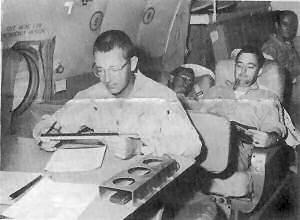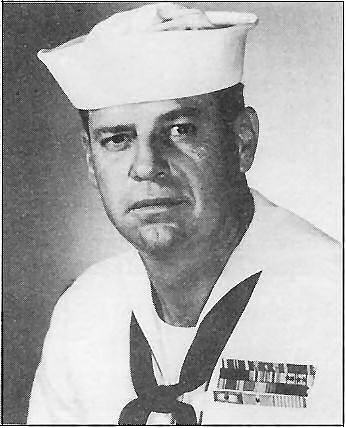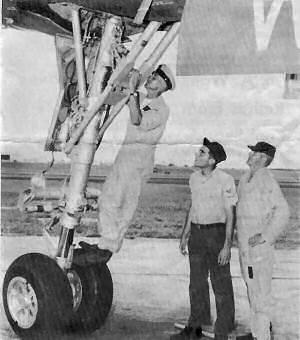VW-1 Moves; Serves:
Hawaii To Guam
 ON AGAIN OFF AGAIN are the two complete crews of VW-1's "Willy Victor." On long flights
it is thus possible for the men to relax and do their paper work between watches.
ON AGAIN OFF AGAIN are the two complete crews of VW-1's "Willy Victor." On long flights
it is thus possible for the men to relax and do their paper work between watches.(U.S. Navy Photo)
This Week airborne Early Warning Squadron ONE marks a decade of airborne radar service to the Pacific fleet. The Squadron celebrates this milestone with a personnel inspection and Family Day Thursday morning and a dinner dance at the Club Tropagana that evening.
VW-1 had a quiet beginning on June 18, 1952 at NAS Barbers Point, Hawaii, where only a handful of officers and men were present for the ceremony. Only a few trusty old PB-1W's (Navy B-17 Flying Fortresses) were lined on the runway. Overnight the first multi-engine land based airborne radar squadron in the Pacific became a beehive of activity. New men had to be trained to operate and maintain the complex radar and communication equipment. These "old-hands" then trained the flood of newcomers arriving to form four other squadrons. These sister squadrons presently provide 24 hour coverage of the highly important DEW (Distant Early Warning) line stretching across the northern Pacific from Hawaii to Midway to Alaska.
 ADR1 Floyd A. Watson
ADR1 Floyd A. Watson10 years ago at commisioning ceremonies of VW-1 Floyd A. Watson ADR1, was a part of the new squadron. In 1961 he reported aboard for his present tour thus becoming the only "plank owner" in today's outfit.
In 1953 VW-1 deployed several crews for a period of combat patrolling along the Korean coastline during the Korean conflict.
 VW-1 MEN PREVENT AIRCRAFT ACCIDENT
VW-1 MEN PREVENT AIRCRAFT ACCIDENTHoward J. Soha, ADRCA; Robert C. Ambrosano, AMS3; and Virgil G. Jackson, AMS2; prevented trouble in their WV-2 aircraft recently. The nose wheel failed to lock properly prior to landing so the plane was forced to circle the field for an hour after a test hop. The three men crawled into an opened forward baggage hatch and were able to shove the safety latch into the "down and locked" position.
(VAP-61 Photo)
In 1954 the first WV-2 Warning Stars, the radar configured version of the Lockheed Super Constellation irliner, were received. Easily distinguishable is the "fin" atop the fuselage which houses the height-finding radar, and the large bubble underneath which houses the distance measuring radar.
VW-1 has had astounding operational success with the WV-2. Over 60,000 accident free flight hours have been accumulated in this remarkable aircraft. In its 10 years and 72,000 flight hours, the squadron has never experienced a major accident. this is truly remarkable when one stops to think that the squadron does all its flying over the vast expanses of the Pacific. Air strips capable of accommodating the WV-2 are usually at least 1,000 miles apart. VW-1 operates from Guam, the Philippines, Okinawa, and Japan while patrolling for fleet units. These over water flights may exceed 18 hours in duration.
VW-1 moved from Hawaii fo Guam in February, 1957. The Commanding Officer of VW-1 has traditionally been Commander Fleet Air Detachment (CFAD) Guam with responsibility for the safety and maintenance of the 7th Fleet aircraft based on Guam. He is also designated Commander Task Group 70.3 (CTG 70.3). The squadron has gained an excellent reputation among fleet units for is quick response to emergency situations, be it the Laos crisis or local search and rescue missions.
VW-1 looks forward with condfidence to another decade of outstanding service to the Navy's Pacific Fleet. The dual mission of radar early warning coverage for the Fleet and weather reconnaissance for the entire western Pacific gives the squadron a very strong operational base.
The squadron's insignia, Paul Revere, mounted on the mythical winged horse, Pegasus, riding to warn the fleet of the approaching enemy will undoubtedly remain both familiar and appropriate to people in WestPac for years to come as they continue to provide early waning of possible enemy aircraft or typhoons.

